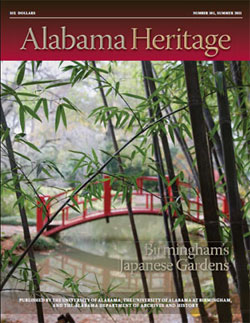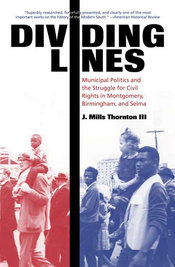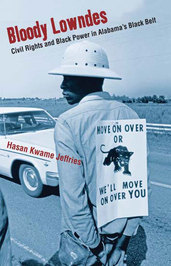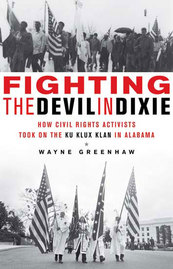|
On the cover: The Japanese Gardens' "Moon Bridge" seen through a stand of beautiful black bamboo. Photo by Randy Connaughten.
|
FEATURE ABSTRACTS
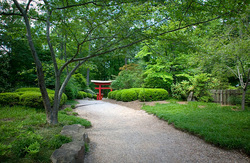 The large red torii
The large red torii marks the entrance to the Japanese Gardens
(Randy Connaughton)
Simple Serenity
Text by Bob Wendorf
Photography by Randy Connaughton
A jewel of the Birmingham Botanical Gardens, the Japanese Gardens have flourished for some forty years, creating a beautiful oasis in the city's midst. The Japanese Gardens are a richly symbolic and spiritual site, encouraging visitors to embark on a literal and metaphorical journey as they travel through the space. Rather than focusing on flowering plants, the Japanese Gardens highlight the significance of spatial relations between objects and encourage a meditative awareness of our role as inhabitants of natural spaces. Incorporating land and water, flora and fauna, natural and man-made structures, the gardens offer an educational respite from the everyday world. Author Bob Wendorf and photographer Randy Connaughton explore the gardens' riches, bringing this simple, yet lovely, site new life.
Additional Information
For a virtual tour of the Birmingham Botanical Gardens, please see their website.
About the Author
Bob Wendorf is a semi-retired clinical psychologist who teaches part-time at the University of Alabama at Birmingham. An Army brat, he was born in Brooklyn, New York, and grew up in Connecticut, Virginia, France, Georgia, and three places in Texas. After receiving his BA from Baylor University in 1969, he attended the University of Illinois, from which he received the Doctor of Psychology degree in 1976. He is author of a dozen published articles in family therapy and two popular psychology books, Make Someone Happy (2008) and Tales from the Couch (in progress). He is married to Margaret Fischer Wendorf and has two sons, Marc and (the late) Karl Wendorf. He has lived in Birmingham and Vestavia Hills for thirty-three years. Bob is cofounder and current president of the Japanese Garden Society of Alabama and was "Volunteer of the Year" at the Birmingham Botanical Gardens in 2008. He is past-president of the Alabama Bonsai Society. His backyard is a Japanese garden.
About the Photographer
Randy Connaughton left architectural practice to complete an MFA in photography from the Savannah College of Art and Design. His photographs are in the collections of the J. Paul Getty Museum and the Library of Congress. Born in New York and raised in Hawaii and Miami, Randy explores the contrasts of the urban and natural environments, and his approach emphasizes a sensitivity to the nuances of light. He currently resides in Atlanta, where he practices architectural photography and exhibits landscape photographs.
Text by Bob Wendorf
Photography by Randy Connaughton
A jewel of the Birmingham Botanical Gardens, the Japanese Gardens have flourished for some forty years, creating a beautiful oasis in the city's midst. The Japanese Gardens are a richly symbolic and spiritual site, encouraging visitors to embark on a literal and metaphorical journey as they travel through the space. Rather than focusing on flowering plants, the Japanese Gardens highlight the significance of spatial relations between objects and encourage a meditative awareness of our role as inhabitants of natural spaces. Incorporating land and water, flora and fauna, natural and man-made structures, the gardens offer an educational respite from the everyday world. Author Bob Wendorf and photographer Randy Connaughton explore the gardens' riches, bringing this simple, yet lovely, site new life.
Additional Information
For a virtual tour of the Birmingham Botanical Gardens, please see their website.
About the Author
Bob Wendorf is a semi-retired clinical psychologist who teaches part-time at the University of Alabama at Birmingham. An Army brat, he was born in Brooklyn, New York, and grew up in Connecticut, Virginia, France, Georgia, and three places in Texas. After receiving his BA from Baylor University in 1969, he attended the University of Illinois, from which he received the Doctor of Psychology degree in 1976. He is author of a dozen published articles in family therapy and two popular psychology books, Make Someone Happy (2008) and Tales from the Couch (in progress). He is married to Margaret Fischer Wendorf and has two sons, Marc and (the late) Karl Wendorf. He has lived in Birmingham and Vestavia Hills for thirty-three years. Bob is cofounder and current president of the Japanese Garden Society of Alabama and was "Volunteer of the Year" at the Birmingham Botanical Gardens in 2008. He is past-president of the Alabama Bonsai Society. His backyard is a Japanese garden.
About the Photographer
Randy Connaughton left architectural practice to complete an MFA in photography from the Savannah College of Art and Design. His photographs are in the collections of the J. Paul Getty Museum and the Library of Congress. Born in New York and raised in Hawaii and Miami, Randy explores the contrasts of the urban and natural environments, and his approach emphasizes a sensitivity to the nuances of light. He currently resides in Atlanta, where he practices architectural photography and exhibits landscape photographs.
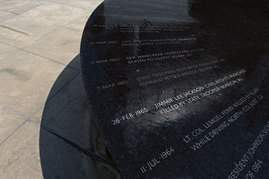 The killing of Jimmie Lee Jackson
The killing of Jimmie Lee Jacksonis commemorated on the Civil Rights Memorial
in Montgomery
(Robin McDonald)
Requiem for Jimmie Lee Jackson
By Wayne Greenhaw
Editor's Note: This must be our requiem to Wayne Greenhaw, who died May 31, just as we were finalizing this piece for publication. Based on the last of his 22 books, Fighting the Devil in Dixie: How Civil Rights Activists Took on the Ku Klux Klan in Alabama (2011, Lawrence Hill Books), it reflects this great writer's passion for justice.
The Selma-to-Montgomery March holds a prominent place among civil rights protests, but few people know that the idea was spawned from grief at the funeral of a martyr—Jimmie Lee Jackson. By 1965 Selma was becoming an epicenter for voters' registration movements, raising tensions in the city and surrounding area. Efforts by blacks to register or to break other racial barriers had violent and humiliating reprisals for white law enforcement personnel. In the spring of 1965, protestors gathered in Marion, Alabama, to encourage the activists to stand firm. Among them was Jackson, who was shot by a trooper. Upon his subsequent death, organizers vowed that it would not be in vain, and they began planning the march on Selma as a fitting tribute to the young man who lost his life for the civil rights cause.
By Wayne Greenhaw
Editor's Note: This must be our requiem to Wayne Greenhaw, who died May 31, just as we were finalizing this piece for publication. Based on the last of his 22 books, Fighting the Devil in Dixie: How Civil Rights Activists Took on the Ku Klux Klan in Alabama (2011, Lawrence Hill Books), it reflects this great writer's passion for justice.
The Selma-to-Montgomery March holds a prominent place among civil rights protests, but few people know that the idea was spawned from grief at the funeral of a martyr—Jimmie Lee Jackson. By 1965 Selma was becoming an epicenter for voters' registration movements, raising tensions in the city and surrounding area. Efforts by blacks to register or to break other racial barriers had violent and humiliating reprisals for white law enforcement personnel. In the spring of 1965, protestors gathered in Marion, Alabama, to encourage the activists to stand firm. Among them was Jackson, who was shot by a trooper. Upon his subsequent death, organizers vowed that it would not be in vain, and they began planning the march on Selma as a fitting tribute to the young man who lost his life for the civil rights cause.
Additional Information
The following articles in the Encyclopedia of Alabama will also be of interest:
About the Author
Wayne Greenhaw's 22nd book, Fighting the Devil in Dixie: How Civil Rights Activists Took on the Ku Klux Klan in Alabama, was published by Lawrence Hill Books. As a reporter for The Alabama Journal in Montgomery, he was a Nieman Fellow at Harvard in 1972–73. In 2006, Greenhaw was presented the Harper Lee Award for Alabama's Distinguished Writer. In 2005, he was given the Clarence Cason Award for Nonfiction by the University of Alabama's College of Communication and Information Sciences.The Thunder of Angels: The Montgomery Bus Boycott and the People Who Broke the Back of Jim Crow was written with Donnie Williams. Born in north Alabama, Greenhaw graduated from the University of Alabama and attended the Instituto Allende in San Miguel de Allende, Mexico. He and his wife Sally divided their time between Montgomery, Alabama, and San Miguel de Allende, Mexico, until his death May 31, 2011.
The following articles in the Encyclopedia of Alabama will also be of interest:
- Wayne Greenhaw
- Jimmie Lee Jackson
- Selma-to-Montgomery March article
- Selma-to-Montgomery March (gallery)
About the Author
Wayne Greenhaw's 22nd book, Fighting the Devil in Dixie: How Civil Rights Activists Took on the Ku Klux Klan in Alabama, was published by Lawrence Hill Books. As a reporter for The Alabama Journal in Montgomery, he was a Nieman Fellow at Harvard in 1972–73. In 2006, Greenhaw was presented the Harper Lee Award for Alabama's Distinguished Writer. In 2005, he was given the Clarence Cason Award for Nonfiction by the University of Alabama's College of Communication and Information Sciences.The Thunder of Angels: The Montgomery Bus Boycott and the People Who Broke the Back of Jim Crow was written with Donnie Williams. Born in north Alabama, Greenhaw graduated from the University of Alabama and attended the Instituto Allende in San Miguel de Allende, Mexico. He and his wife Sally divided their time between Montgomery, Alabama, and San Miguel de Allende, Mexico, until his death May 31, 2011.
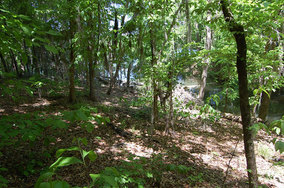 The Creek settlement of Ikanachaki, or Holy Ground,
The Creek settlement of Ikanachaki, or Holy Ground,was situated on this bluff on House Creek
(Robin McDonald)
Return to Holy Ground: The Legendary Battle Site Discovered
By Gregory Waselkov
In 1813 Ikanachaki, or Holy Ground—a site considered sacred by the Redstick Creeks—turned from a site of peace to a site of war. Conflicts between European settlers and Native Americans, particularly the various factions of Creek Indians, had erupted over cultural identity and land rights. Led by General Ferdinand Claiborne, the settlers secured the site. In the aftermath of the battle and the remainder of the Creek Wars, the site's precise location became obscured. Over generations, various spots were accepted as Holy Ground. But thanks to tireless and painstaking archaeological work, experts have recently located the actual site of Holy Ground. Archaeologist Greg Waselkov details how this historic and significant discovery was made, and he explains the work still being done to preserve and protect this sacred space.
Additional Information
This material is based upon work assisted by a grant from the Department of the Interior, National Park Service. Any opinions, findings, and conclusions or recommendation expressed in this material are those of the author and do not necessarily reflect the views of the Department of the Interior.
For more information or to find out how you can help the Archaeological Conservancy acquire and preserve this historic place, please contact them at 5301 Central Avenue NE, Suite 902, Albuquerque, New Mexico, 87108-1517. You may also call (505) 266-1540, or visit their website.
We also suggest the following article in the Encyclopedia of Alabama:
• Holy Ground
About the Author
Gregory A. Waselkov is professor of anthropology and director of the Center for Archaeological Studies at the University of South Alabama. His research concerns the prehistory and colonial ethnohistory of the Southeast. He co-edited William Bartram on the Southeastern Indianswith Kathryn Braund (University of Nebraska Press, 1995) andPowhatan's Mantle: Indians of the Colonial Southeast with Peter Wood and Tom Hatley (University of Nebraska Press, 2006) and wrote Old Mobile Archaeology (University of Alabama Press, 1999) about the French at 27-Mile Bluff between 1702 and 1711. His book, A Conquering Spirit: Fort Mims and the Redstick War of 1813–1814(University of Alabama Press, 2006), won the Alabama Historical Association's Clinton Jackson Coley Award and the Alabama Library Association's Adult Nonfiction Book of the Year award. He's currently working on guidebooks with Kathryn Braund and Raven Christopher on the Old Federal Road and on Creek War sites in Alabama.
By Gregory Waselkov
In 1813 Ikanachaki, or Holy Ground—a site considered sacred by the Redstick Creeks—turned from a site of peace to a site of war. Conflicts between European settlers and Native Americans, particularly the various factions of Creek Indians, had erupted over cultural identity and land rights. Led by General Ferdinand Claiborne, the settlers secured the site. In the aftermath of the battle and the remainder of the Creek Wars, the site's precise location became obscured. Over generations, various spots were accepted as Holy Ground. But thanks to tireless and painstaking archaeological work, experts have recently located the actual site of Holy Ground. Archaeologist Greg Waselkov details how this historic and significant discovery was made, and he explains the work still being done to preserve and protect this sacred space.
Additional Information
This material is based upon work assisted by a grant from the Department of the Interior, National Park Service. Any opinions, findings, and conclusions or recommendation expressed in this material are those of the author and do not necessarily reflect the views of the Department of the Interior.
For more information or to find out how you can help the Archaeological Conservancy acquire and preserve this historic place, please contact them at 5301 Central Avenue NE, Suite 902, Albuquerque, New Mexico, 87108-1517. You may also call (505) 266-1540, or visit their website.
We also suggest the following article in the Encyclopedia of Alabama:
• Holy Ground
About the Author
Gregory A. Waselkov is professor of anthropology and director of the Center for Archaeological Studies at the University of South Alabama. His research concerns the prehistory and colonial ethnohistory of the Southeast. He co-edited William Bartram on the Southeastern Indianswith Kathryn Braund (University of Nebraska Press, 1995) andPowhatan's Mantle: Indians of the Colonial Southeast with Peter Wood and Tom Hatley (University of Nebraska Press, 2006) and wrote Old Mobile Archaeology (University of Alabama Press, 1999) about the French at 27-Mile Bluff between 1702 and 1711. His book, A Conquering Spirit: Fort Mims and the Redstick War of 1813–1814(University of Alabama Press, 2006), won the Alabama Historical Association's Clinton Jackson Coley Award and the Alabama Library Association's Adult Nonfiction Book of the Year award. He's currently working on guidebooks with Kathryn Braund and Raven Christopher on the Old Federal Road and on Creek War sites in Alabama.
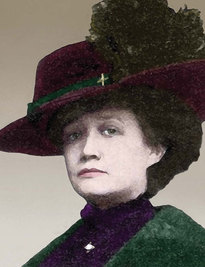 Photo-illustration of Ola Delight Cook
Photo-illustration of Ola Delight Cook(Robin McDonald)
Southern Delight
By Ruthmary Williams
Ola Delight Lloyd Smith Cook had a formidable name, but it was no match for her ambition and determination. An early twentieth-century advocate for workers' rights, Cook devoted her life to serving others and ensuring their well-being. Cook's training as a telegraph operator at the Alabama Girls' Industrial School set her on a career path that she would later develop into a lifetime of advocacy and activism. Cook's work took her across the nation. She worked as a strike organizer for American Federation of Labor and eventually became known as the "First Lady of Oregon Labor." Throughout it all, this significant woman drew on the lessons she learned in her time in the South.
About the Author
Ruthmary Williams is an Auburn native who completed her undergraduate studies at Auburn University. She holds an MS degree in American history from the University of South Florida in Tampa, where she focused on women's history and Florida history. Her article "Sarasota: Hardship and Tourism in the 1930s" was published in theFlorida Historical Quarterly. She currently lives in Sarasota, Florida, and teaches American history as an adjunct professor for State College of Florida. She also is serving a four-year term on the Sarasota County Historical Commission.
By Ruthmary Williams
Ola Delight Lloyd Smith Cook had a formidable name, but it was no match for her ambition and determination. An early twentieth-century advocate for workers' rights, Cook devoted her life to serving others and ensuring their well-being. Cook's training as a telegraph operator at the Alabama Girls' Industrial School set her on a career path that she would later develop into a lifetime of advocacy and activism. Cook's work took her across the nation. She worked as a strike organizer for American Federation of Labor and eventually became known as the "First Lady of Oregon Labor." Throughout it all, this significant woman drew on the lessons she learned in her time in the South.
About the Author
Ruthmary Williams is an Auburn native who completed her undergraduate studies at Auburn University. She holds an MS degree in American history from the University of South Florida in Tampa, where she focused on women's history and Florida history. Her article "Sarasota: Hardship and Tourism in the 1930s" was published in theFlorida Historical Quarterly. She currently lives in Sarasota, Florida, and teaches American history as an adjunct professor for State College of Florida. She also is serving a four-year term on the Sarasota County Historical Commission.
DEPARTMENT ABSTRACTS
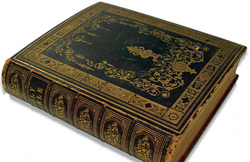 The Alabama State Bible
The Alabama State Bible(Alabama Department of Archives and History)
Southern Religion
The Battle Is God's (And He's On Our Side): Divine Providence in the Civil War
By George C. Rable
Most readers are well-versed in the mounting factional tensions contributing to the outbreak of Civil War, but an often-overlooked area of study concerns the role religion played in coping with the war. George Rable discusses the way that both northern and southern citizens used religious beliefs to substantiate their participation in the conflict—and to justify their reasons for fighting in the first place.
About the Author
George C. Rable is the Charles G. Summersell Professor of Southern History at the University of Alabama and author of God's Almost Chosen Peoples: A Religious History of the American Civil War(University of North Carolina Press, 2010), winner of the Museum of the Confederacy's 2010 Jefferson Davis Award.
About the Editor
Joshua D. Rothman, standing editor of the "Southern Religion" department of Alabama Heritage, is associate professor of history at the University of Alabama and director of the university's Frances S. Summersell Center for the Study of the South, which sponsors this department.
The Battle Is God's (And He's On Our Side): Divine Providence in the Civil War
By George C. Rable
Most readers are well-versed in the mounting factional tensions contributing to the outbreak of Civil War, but an often-overlooked area of study concerns the role religion played in coping with the war. George Rable discusses the way that both northern and southern citizens used religious beliefs to substantiate their participation in the conflict—and to justify their reasons for fighting in the first place.
About the Author
George C. Rable is the Charles G. Summersell Professor of Southern History at the University of Alabama and author of God's Almost Chosen Peoples: A Religious History of the American Civil War(University of North Carolina Press, 2010), winner of the Museum of the Confederacy's 2010 Jefferson Davis Award.
About the Editor
Joshua D. Rothman, standing editor of the "Southern Religion" department of Alabama Heritage, is associate professor of history at the University of Alabama and director of the university's Frances S. Summersell Center for the Study of the South, which sponsors this department.
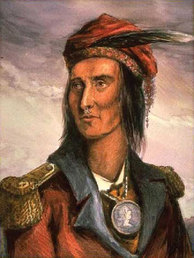 1868 portrait of Tecumseh
1868 portrait of Tecumsehby Benson John Lossing
(Lossing, "The Pictoral Field-book
of the War of 1812")
Becoming Alabama
Quarter by Quarter
By Joseph W. Pearson, Megan L. Bever, and Matthew L. Downs
Editor’s Note: Alabama Heritage, the Summersell Center for Study of the South, the University of Alabama Department of History, and the Alabama Tourism Department offer this department as a part of the statewide “Becoming Alabama” initiative—a cooperative venture of state organizations to commemorate Alabama’s experiences related to the Creek War, the Civil War, and the civil rights movement. Quarter by quarter we will take you to the corresponding seasons 200, 150, and 50 years ago—sometimes describing the most pivotal events, sometimes describing daily life, but always illuminating a world in flux. We will wait for the ultimate outcomes as our forbears did—over time. For those joining the story in progress, you can find earlier quarters on our website.
Joseph Pearson details Tecumseh's preparations to journey south into territory occupied by disparate tribes. Along with other Native American leaders, Tecumseh believed that the only way to defeat encroaching European settlers was for natives to put aside tribal differences and unite. He believed that their way of life—and even their very survival—depended on the success of his journey. Megan Bever explores a different set of factions that brewed across the south fifty years later, when Confederates decided to relocate their capital from Montgomery, Alabama, to Richmond, Virginia. And finally, Matthew Downs looks at the summer of 1961, when Freedom Riders traversed the southeast, where more often than not, they were met with aggression and violence.
Additional Information
We also suggest the following articles in the Encyclopedia of Alabama:For information on the Freedom Rides, consult the excellent PBS website.
About the Authors
Joseph W. Pearson is a PhD student in the department of history at the University of Alabama. His research interests include the nineteenth-century South, antebellum politics, and political culture.
Megan L. Bever is currently a doctoral student in the department of history at the University of Alabama. Her research interests include the nineteenth-century South and the Civil War in American culture.
Matthew L. Downs (PhD, Alabama) is an assistant professor of history at the University of Alabama at Birmingham. His dissertation focused on the federal government’s role in the economic development of the Tennessee Valley.
Quarter by Quarter
By Joseph W. Pearson, Megan L. Bever, and Matthew L. Downs
Editor’s Note: Alabama Heritage, the Summersell Center for Study of the South, the University of Alabama Department of History, and the Alabama Tourism Department offer this department as a part of the statewide “Becoming Alabama” initiative—a cooperative venture of state organizations to commemorate Alabama’s experiences related to the Creek War, the Civil War, and the civil rights movement. Quarter by quarter we will take you to the corresponding seasons 200, 150, and 50 years ago—sometimes describing the most pivotal events, sometimes describing daily life, but always illuminating a world in flux. We will wait for the ultimate outcomes as our forbears did—over time. For those joining the story in progress, you can find earlier quarters on our website.
Joseph Pearson details Tecumseh's preparations to journey south into territory occupied by disparate tribes. Along with other Native American leaders, Tecumseh believed that the only way to defeat encroaching European settlers was for natives to put aside tribal differences and unite. He believed that their way of life—and even their very survival—depended on the success of his journey. Megan Bever explores a different set of factions that brewed across the south fifty years later, when Confederates decided to relocate their capital from Montgomery, Alabama, to Richmond, Virginia. And finally, Matthew Downs looks at the summer of 1961, when Freedom Riders traversed the southeast, where more often than not, they were met with aggression and violence.
Additional Information
We also suggest the following articles in the Encyclopedia of Alabama:For information on the Freedom Rides, consult the excellent PBS website.
About the Authors
Joseph W. Pearson is a PhD student in the department of history at the University of Alabama. His research interests include the nineteenth-century South, antebellum politics, and political culture.
Megan L. Bever is currently a doctoral student in the department of history at the University of Alabama. Her research interests include the nineteenth-century South and the Civil War in American culture.
Matthew L. Downs (PhD, Alabama) is an assistant professor of history at the University of Alabama at Birmingham. His dissertation focused on the federal government’s role in the economic development of the Tennessee Valley.
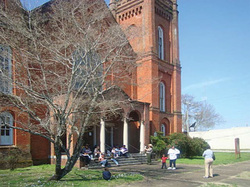 Junior Rangers listen to a talk
Junior Rangers listen to a talkby a park ranger on the steps of
Tuskegee's First United Methodist Church
(Tuskegee Youth Safe Haven)
Southern Architecture and Preservation
"One Brick at a Time": Junior Rangers Learn Hands-On History
By Shirley Baxter
In Tuskegee, an innovative National Park Service program teaches young people about architectural history and historic preservation, utilizing a landmark college campus and nearby historic streetscapes. The Junior Ranger program, called "One Brick at a Time," incorporates youngsters from the community into educational programs, drawing on the site's unique resources to teach the children about architecture and history.
Additional Information
For more information about the site, please visit its website.
About the Author
For more information contact Shirley Baxter at Tuskegee Institute National Historic Site (334-727-3200 or via email).
About the Editor
Robert Gamble, standing editor of the "Southern Architecture and Preservation" department of Alabama Heritage, is senior architectural historian for the Alabama Historical Commission.
"One Brick at a Time": Junior Rangers Learn Hands-On History
By Shirley Baxter
In Tuskegee, an innovative National Park Service program teaches young people about architectural history and historic preservation, utilizing a landmark college campus and nearby historic streetscapes. The Junior Ranger program, called "One Brick at a Time," incorporates youngsters from the community into educational programs, drawing on the site's unique resources to teach the children about architecture and history.
Additional Information
For more information about the site, please visit its website.
About the Author
For more information contact Shirley Baxter at Tuskegee Institute National Historic Site (334-727-3200 or via email).
About the Editor
Robert Gamble, standing editor of the "Southern Architecture and Preservation" department of Alabama Heritage, is senior architectural historian for the Alabama Historical Commission.
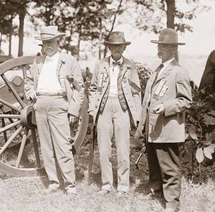 Veterans from both sides
Veterans from both sides at the fiftieth anniversary of Gettysburg
(Library of Congress)
Southern Folkways
Listening for the Rebel Yell
By Elizabeth Wade
It remains one of the most iconic sounds of the Civil War, but few people even know what it actually sounded like. Elizabeth Wade tracks down accounts of the Rebel Yell, detailing its emergence and employment in the Civil War era and chronicling attempts to preserve it and recognize its cultural significance.
Additional Information
For a link to a video of Civil War re-enactors simulating the Rebel yell, click here.
About the Author
Elizabeth Wade serves as an assistant editor of Alabama Heritage magazine.
Listening for the Rebel Yell
By Elizabeth Wade
It remains one of the most iconic sounds of the Civil War, but few people even know what it actually sounded like. Elizabeth Wade tracks down accounts of the Rebel Yell, detailing its emergence and employment in the Civil War era and chronicling attempts to preserve it and recognize its cultural significance.
Additional Information
For a link to a video of Civil War re-enactors simulating the Rebel yell, click here.
About the Author
Elizabeth Wade serves as an assistant editor of Alabama Heritage magazine.
Reading the Southern Past
Civil Rights in Alabama: Urban and Rural
By Stephen Goldfarb
In this quarter's installment of Reading the Southern Past, Stephen Goldfarb reviews several books connected to the civil rights movement, focusing particularly on the movement's inflection in areas with variations in population density. Goldfarb considers J. Mills Thornton III's Dividing Lines: Municipal Politics and the Struggle for Civil Rights in Montgomery, Birmingham, and Selma (University of Alabama Press, 2002), Hasan Kwame Jeffries's Bloody Lowndes: Civil Rights and Black Power in Alabama's Black Belt (New York University Press, 2009), and Wayne Greenhaw's Fighting the Devil in Dixie: How Civil Rights Activists Took on the Ku Klux Klan in Alabama (Lawrence Hill Books, 2011).
About the Author
Stephen Goldfarb holds a PhD in the history of science and technology. He retired from a public library in 2003.
Civil Rights in Alabama: Urban and Rural
By Stephen Goldfarb
In this quarter's installment of Reading the Southern Past, Stephen Goldfarb reviews several books connected to the civil rights movement, focusing particularly on the movement's inflection in areas with variations in population density. Goldfarb considers J. Mills Thornton III's Dividing Lines: Municipal Politics and the Struggle for Civil Rights in Montgomery, Birmingham, and Selma (University of Alabama Press, 2002), Hasan Kwame Jeffries's Bloody Lowndes: Civil Rights and Black Power in Alabama's Black Belt (New York University Press, 2009), and Wayne Greenhaw's Fighting the Devil in Dixie: How Civil Rights Activists Took on the Ku Klux Klan in Alabama (Lawrence Hill Books, 2011).
About the Author
Stephen Goldfarb holds a PhD in the history of science and technology. He retired from a public library in 2003.
